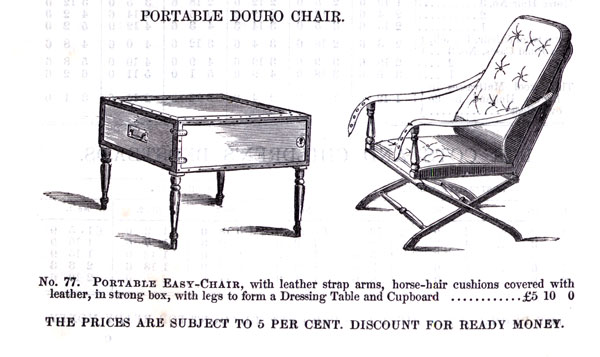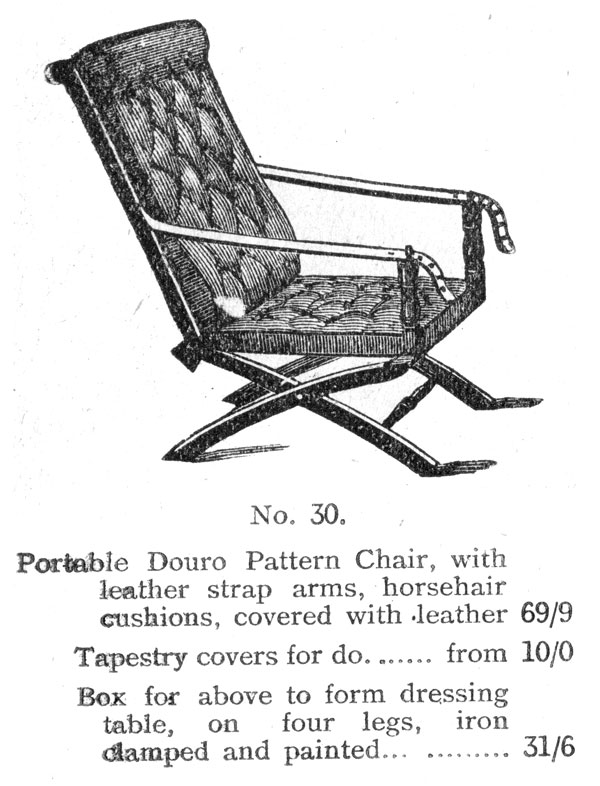We may receive a commission when you use our affiliate links. However, this does not impact our recommendations.
You would think that after 30 months of researching and building campaign furniture, I’d be ready to build something else. Such as something that didn’t collapse, fold or have copious amounts of brass hardware.
But no. I am nuts for the Douro chair. It’s a reclining chair with leather cushions, yet it pre-dates the Morris chair by many decades. Not only is it a very comfortable chair (I sat in one this fall), but it folds up to travel in a box. And that box converts to a convenient side table with turned legs.
The earliest Douro chair I’m aware of is shown in a painting that is circa 1835, which was found by Simon and Sean Clarke of Christopher Clarke Antiques in England. I’ve not been able to find any references that early; many of the references to the chair I’ve found start popping up about 1850, which is when it appeared in the Sydney Morning Herald (Oct. 9, 1850, and Dec. 21, 1850) and in the Bermuda Royal Gazette (Aug. 27, 1850).
In any case, the Douro was an enduring design produced by many makers and even was produced in an iron version. I’ve found catalog listings for Douros in the 1907 Army & Navy Co-operative Society catalog. That’s a long run for a chair design.
The chair’s mechanism is like a modified director’s chair. The base is a simple folding X-frame. The chair’s back is hinged to one end of the frame. The front posts of the chair are also hinged (typically) to the front of the base.
The seat and back are caned. And the whole thing is covered by a folding leather cushion.
You can recline the back using the heavy leather arm straps. There are holes in the straps, which can be moved to different positions. Some Douros were even used as beds in a pinch and appear with footrests.
The chair was typically made in birch, mahogany or oak.
Interestingly, the Douro (allegedly named for the Marquis of Douro), was often recommended for homemakers as an ideal chair for invalids.
Other kinds can, however, be used, if preferred; one of a simple construction is shown at figure 25, said to have been invented by the Marquis of Douro, whence its name, Douro chair. The back is hinged where it joins the seat, so as to alter its slope, like the bedchair described above. The elbows are two leather straps, with holes pierced at their outer ends, which fit over a small brass nob fixed in the upright, and so hold the back in any position. The bottom is formed by a piece of sacking, on which the lower cushion rests. It will thus be seen that this chair is of very simple construction, and it has besides the convenience of folding into a small compass.
— “How to Make a Home and Feed a Family…” Ward & Lock (London), 1857.
I’m headed to England this summer to teach a couple of classes, and I hope to get my hands on a Douro to measure and examine. (If you have one in your garage, let me know.)
— Christopher Schwarz
Here are some supplies and tools we find essential in our everyday work around the shop. We may receive a commission from sales referred by our links; however, we have carefully selected these products for their usefulness and quality.











That’s a sweet chair, I’d love to see one in person or check out some plans. Do any plans exist ?
Did you check out the Chair Museum in High Wycombe when you were here in the summer Chris?? Lots of gems in there. I think the company that were looking after it have recently closed, but I’m sure someone will be looking after it.
Lots of fine furniture still being made in and around this very historically important area. At one time 5000 chairs were being made per week in High Wycombe to be exported around the world. Anyway, good luck with finding the chair. If I get chance I’ll pop to the museum to see if they have one.